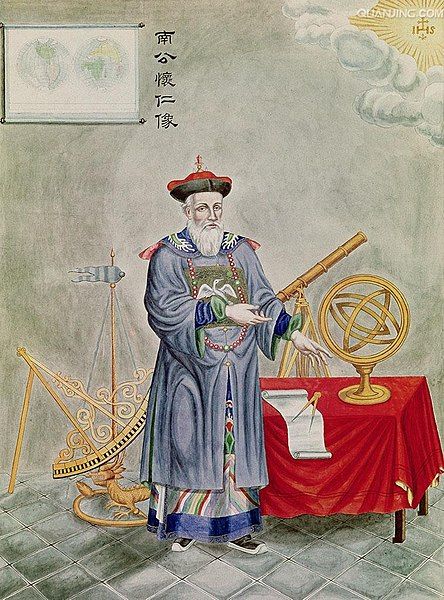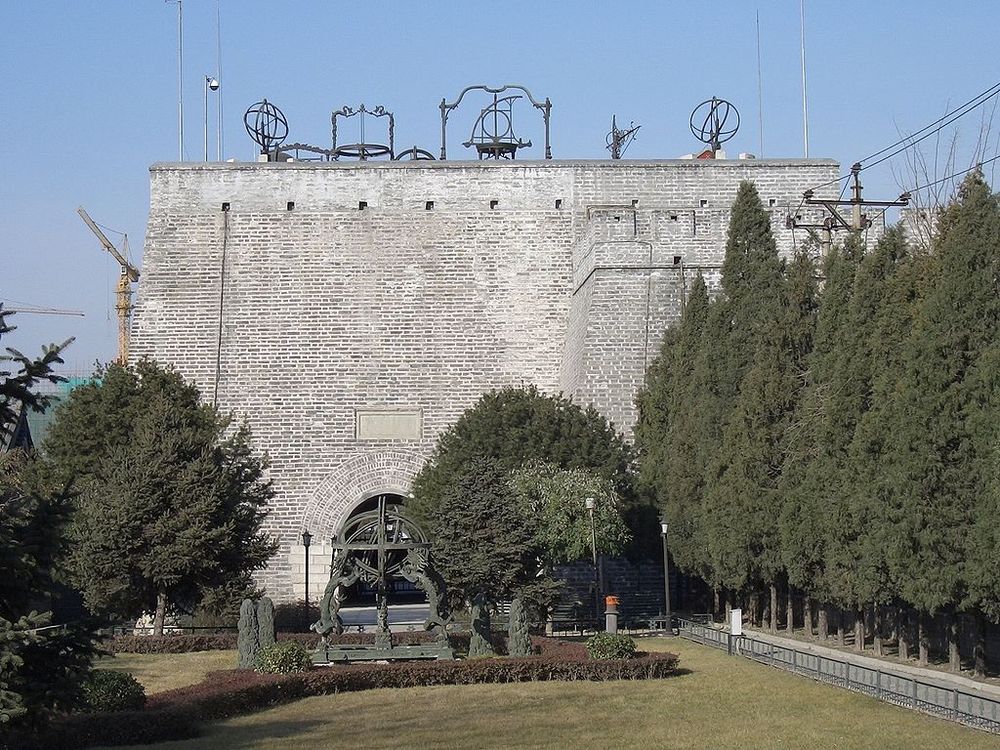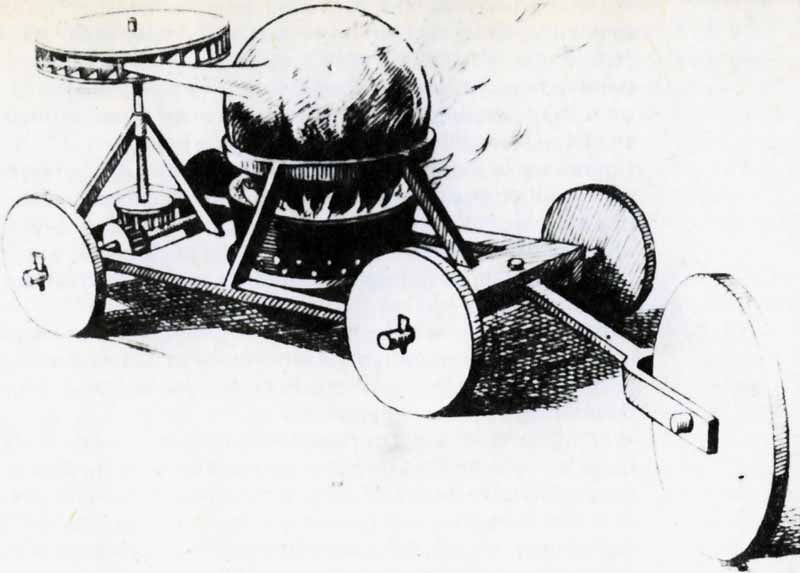On October 9, 1623 Ferdinand Verbiest was born in the town of Pittem (present-day Belgium). Of his early years it is only known that he studied humanities, philosophy and mathematics in Bruges, Cortrique and Louvain. On September 2, 1641 he entered the Society of Jesus, which sent him to Seville to study theology. In the Spanish city he was ordained a priest in 1655 at the age of 32. In Rome he completed his training by studying astronomy.
Ferdinand wanted to be a missionary in Central America, but the Society had other plans for him. Protestantism was thinning the ranks of Catholics in Europe and the Church set its sights on the Far East to keep adding to its numbers. So on April 4, 1657, he embarked from Lisbon for China, accompanied by 35 other missionaries and the Portuguese viceroy of the Indies.

The instruments created by Verbiest at the Beijing Imperial Observatory. Photo: Thomas Childe/Wikimedia
When the ship arrived in Macao on July 17, 1658, only ten of the passengers, including Ferdinand, were still alive. From that date until 1660 he was in charge of the Shaanxi mission. In that year he was appointed assistant to Father Johann Adam Schall von Bell, who was director of the Peking Astronomical Observatory. However, the following year the political situation led to the persecution of the Jesuits, who were forced to go into exile in Canton, where von Bell died.
In 1669 the Kangxi Emperor, who was 15 years old, was informed that serious errors had been found in the calendar for 1670, drawn up by the Chinese astronomer Yang Guangxian (one of the main opponents of the Jesuits). So he called a public test to compare the merits of Chinese and European astronomy, in which Yang and Verbiest were to face each other.

Ferdinand Verbiest.
The test consisted of predicting three things: the length of the shadow cast by a gnomon at noon on a given day; the absolute and relative positions of the Sun and planets on a given date; and the exact time of a predicted lunar eclipse. Verbiest prevailed in all three, thanks mainly to his access to the Rudolphine Tables (the stellar catalog and planetary tables published by Kepler in 1627) and the use of telescopes.
The emperor appointed Ferdinand Verbiest director of the Peking Astronomical Observatory, and the exiled Jesuits were allowed to return to their missions. Verbiest corrected the calendar, to which Yang had added an extra month unnecessarily to hide other errors and to align the lunar months with the solar year.
From there he became the emperor's teacher, teaching him geometry, philosophy and music, and accompanied him on his frequent expeditions throughout the empire. Verbiest devoted himself to numerous projects. He translated the first six books of Euclid into Manchu, built an aqueduct, cast 132 cannons for the imperial army, and even designed a chariot.

The Verbiest instruments at the Beijing Astronomical Observatory. Photo: Wellcome Images/Wikimedia
He also created new star charts, which allowed the emperor to know the time at night, and compiled a table of all solar and lunar eclipses for the next 2,000 years. He then worked to rebuild and improve the Astronomical Observatory, work on which was completed in 1673.
Estimating that all the observatory's instruments were obsolete, he moved them to a museum and designed six new ones:
- An altazimuth mount for telescopes, which allows the position of celestial bodies to be measured in relation to the celestial horizon and the zenith.
- A celestial globe of two meters in diameter, used to map and identify celestial objects.
- An ecliptic armillary sphere also about two meters in diameter, used to measure the difference in ecliptic longitude and latitudes of celestial bodies.
- An equatorial armillary sphere of equal size, used to measure true solar time and the difference in right ascension and declination of celestial bodies.
- An altazimuth quadrant, two meters in radius, to measure altitudes or zenith distances of celestial bodies.
- And a sextant with a radius of 2.44 meters, to measure the angle of elevation of a celestial object above the horizon.
All these instruments were very large, made of brass and lavishly decorated with oriental motifs, with huge bronze dragons as supports. Despite their size and weight, they were easy to manipulate, demonstrating Verbiest's great skill in mechanical design.

Some of the instruments created by Verbiest are still on top of the Ancient Astronomical Observatory in Beijing. Photo: pfctdayelise/Wikimedia
He is also known to have experimented with steam to propel ships, and around 1672 he designed a steam-powered vehicle as a toy for the emperor. He describes it in his manuscript Astronomia Europea (completed in 1681 and published in Germany in 1687), where Verbiest uses for the first time in history the term engine with its current meaning.
As he wrote, with a single filling of coal the vehicle was capable of moving more than an hour. Although due to its small size of just 65 centimeters long it was not designed to transport passengers, it was the first vehicle capable of moving by the force of an autonomous motor.
Since the steam engine had not yet been invented, Verbiest based his design on the aeolipile of Heron of Alexandria, the 1st century AD Greek mathematician. Steam was generated in a ball-shaped boiler, and exited through a tube at the top from where it headed to a simple turbine that powered the rear wheels.

The Verbiest Steam Vehicle. Photo: Wikimedia
However, it is unknown whether Verbiest's design was ever built, as no other source mentions it, nor have any authentic drawings of it come down to us. Had it been so, and Verbiest had Chinese metalworkers capable of building precision instruments at its disposal, it would be the first self-propelled vehicle in history.
Ferndinand Verbiest spent the rest of his life in Peking, dying on January 28, 1688, of injuries sustained in a fall from a horse. He was buried in the Zhalan Jesuit Cemetery, near his friend and teacher Johann Adam Schall von Bell. He was the only Westerner in the entire history of China to be granted a posthumous name by an emperor: Nan Huai Ren.
In 1988 the Chinese government donated an exact replica of Verbiest's celestial globe to the University of Louvain (Belgium), which can now be seen outside the institute that bears the Jesuit's name. It weighs 3,850 kilograms and has a total of 1,888 stars and celestial bodies etched in bronze, the number known when Verbiest created it.

The replica of the celestial globe outside the Verbiest Institute of the University of Leuven. Photo: FrDr/Wikimedia
This article was originally published in La Brújula Verde. It has been translated from Spanish and republished with permission.



Comments
Post a Comment